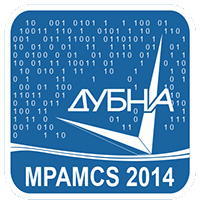Speaker
Mr
Ilia Rogojin
(JINR)
Description
A.Khvedelidze and I.Rogojin
Laboratory of Information Technologies,
Joint Institute for Nuclear Research, Dubna, Russia
I. Introduction
With this article we aim to discuss quantum effects in charged spin-1/2 particle dynamics caused by a high intensity of a laser field.
A charged particle's dynamics in the electromagnetic background, classical as well as quantum strongly depends on the vales of a electromagnetic field strength. When the intensity of a time dependent electromagnetic field is low the standard dipole approximation is well justifiable and consistent with the non-relativistic treatment of a charged particle dynamics [1]. With the growing intensity the retardation effects and the influence of the magnetic part of the Heaviside-Lorentz cannot be ignored. In another words a charged particle's classical motion is ruled out by a nonlinear equations. This, particularly, leads to a higher order harmonics appearance in the Thomson scattering radiation pattern (cf. [2,3,4]). Moreover, it turns that the background radiation intensity plays affects a charged particle's spin evolution as well. It is well established that for a vanishing field strength a charged particle's spin behaves adiabatically, linearly responding to the magnetic component of the electromagnetic field. When intensity is increasing the standard quantum-mechanical dipole approximation breaks down, non-linear effects come in force and the adiabatic non-relativistic picture of spin precession turns to be inadequate and relativistic treatment becomes necessary (see detailed discussion in [5,6] and references therein).
In the present work, having in mind the necessity of the dipole approximation scheme modification, we will discuss the dynamics in an “intermediate regime”, when the values of a laser field strength lead to the post non-relativistic type of dynamics. We address the question what is the effect of complete treatment of the Heaviside-Lorentz force (non ignoring its magnetic part) on the particle's spin evolution. Concentrating on a charged spin-1/2 particle motion in a strong monochromatic plane wave and the induced evolution of particle's spin, the deviation from the standard spin precession will be demonstrated. The claimed results developed out of our studies of a charged particle's classical dynamics beyond the dipole approximation [4] and the semi-classical analysis of the spin-1/2 evolution in a strong laser field [5,6].
II Deviations from the dipole approximation results
Within the semi-classical approach, one can point several examples of deviations of particle's spin evolution from its non-relativistic adiabatic counterpart. The combined action of several factors, such as the retardation effect, the role of the magnetic part of Heaviside-Lorentz force in distortion of a particle's classical orbit as well as the Thomas correction, brings changes into the non-relativistic result of adiabatic spin precession. Taking into account all these factors we will show that instead of an expected adiabatic behavior of a particle's spin the following manifestations of a laser intensity impact occurs:
• A spin-flipping process in a strong monochromatic plane with the resonant form of the spin-flipping transition probability with respect to a laser intensity;
• Effect of non-linear dependence of a spin precession frequency on a laser intensity and polarization;
• Appearance of a non-trivial, intensity depended phase of a particle’s wave function in a strong circularly polarized laser field background.
III Concluding remarks
Analytical and numeric studies of the modified Pauli equation for a charged spin-1/2 particle' s interacting with the elliptically laser field have been performed. Several effects, including the spin-flipping resonance depending on polarization, have been found taking into account the relativistic corrections due to the laser field intensity.
References
1. J.D. Jackson, Classical electrodynamics, - New York , Wiley, 1999.
2. N.D.Sengupta, On the scattering of electromagnetic waves by free electron, Bull. of Calcutta Math. Soc.41, 187, 1949.
3. E.S. Sarachik and G.T. Schappert, Classical theory of the scattering of intense laser radiation by free electronPhys. Rev. D1, 2738, 1970.
4. P. Jameson and A.Khvedelidze, Classical dynamics of a charged particle in a laser field beyond the dipole approximation, Phys. Rev.A77, 053403 2008.
5. M.Eliashvili, V.Gerdt and A.Khvedelidze, On precession of entangled spins in a strong laser field, Phys. of Atomic Nuclei 72 No. 5, 786, 2009.
6. V.Gerdt, S.Gogilidze, A.Khvedelidze, D.Mladenov and V.Sanadze, Entanglement of spins under a strong laser influence, Phys. Scr. T153, 014026, 2013.
Authors
Mr
Arsen Khvedelidze
(JINR)
Mr
Ilia Rogojin
(JINR)

